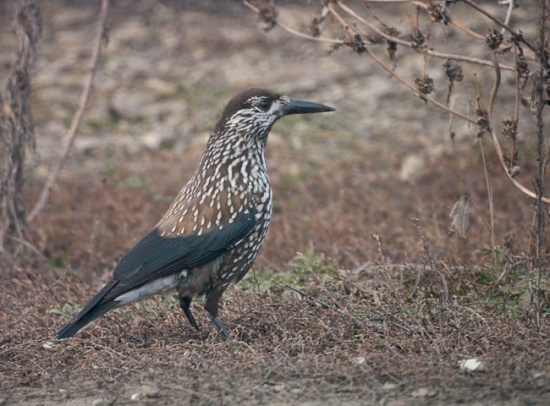Alternative name: Spotted Nutcracker
- Nucifraga caryocatactes
Identification
Length 32 - 34 cm; (12 - 13 inches) weight 124 - 220 g. A distinctive, medium-sized corvid:
- Dark brown plumage with white spots and streaks, most densely on side of head
- Plain dark brown rump and uppertail-coverts
- White undertail-coverts and lower belly
- Glossy black upperwing
- Glossy black tail with white feather tips
- Dark brown eye
- Black bill and legs
The subspecies differ in density and size of white spots and size of the bill.
Sexes similar, juveniles have dull brown wings and a broad white tip on the median coverts.
The Northern subspecies have been noted as having a stronger spotted body as compared to the weaker spotted bodies of the Southern ones.
Distribution
The mountains of central and southeast Europe, locally in southern Scandinavia and European Russia, widely across northern Asia from the Ural Mountains east to the Pacific, and locally in eastern Asia, including Japan, Taiwan, central and southwestern China, and the Himalaya.
Locally common in suitable pine forest habitats.
Taxonomy
Large-spotted Nutcracker was formerly included in this species. Some authors in the past have split the southeastern group of subspecies (below) as a separate species N. hemispila, but this is not currently accepted.[2] These two species are in turn related to Clark's Nutcracker in western North America.
This is a polytypic species[1] consisting of 9 subspecies:
Subspecies
- N. c. caryocatactes in Scandinavia to northern and eastern Europe; > to southern Russia.
- N. c. macrorhynchos in Northern and northeastern Asia; irruptions to northern Iran, Korea and northern China
- N. c. rothschildi in Tien Shan Mountains, Kazakhstan
- N. c. japonica in the central and southern Kuril Islands, Hokkaido and Honshu
- N. c. owstoni in Taiwan
- N. c. interdicta in the mountains of north-central China
- N. c. macella in the eastern Himalaya from Nepal to Bhutan and northeast India, and the mountains of southwest and central China
- N. c. yunnanensis in Southwestrn China (Yunnan)
- N. c. hemispila in the Himalayas (western Nepal to southern Kashmir)
Several additional subspecies have been proposed, but are not widely accepted. N. c. relicta (Alps) and N. c. wolfi (Balkans) are now considered synonyms of N. c. caryocatactes, while N. c. yunnanensis from south-western China is treated as a synonym of N. c. macella.[2]
Habitat
Taiga conifer forests and mixed conifer forest, usually with a significant white pine (Pinus subgenus Strobus) component. Occurs from lowlands in the north of its range, up to 2500 m in Europe, and to 4000 m in Nepal.
Behaviour
Usually seen in pairs or family parties and has little fear of humans, though very secretive during the nesting season.
Movements
All populations are usually resident, but in some years, cone crop failures can force big movements, with birds from Siberia (N. c. macrorhynchos) reaching as far west as Europe in certain winters. Most of these eruptive movements end in the death of the birds, but some return to their natal area, and some can establish new colonisations; a small population of N. c. macrorhynchos is now established at Punkaharju in Finland, colonising the forestry and ornamental plantations of Pinus sibirica and P. peuce there.[3]
Diet
They eat seeds from various species of white pines (notably Pinus cembra, P. peuce in Europe, P. armandii, P. pumila, P. sibirica, P. wallichiana in Asia). To a smaller extent they also eat spruce Picea seeds and hazel Corylus nuts; these latter are important in northern Europe where white pines do not occur naturally. Their diet also includes birds eggs,nestlings and insects including bee and wasp grubs.
Stores large quantities of nuts (up to 100,000 per bird) in its winter territory, using its exceptional spatial memory to retrieve the seeds up to 8-10 months later and even from under deep winter snow cover. Caches them often at the base of a tree, behind moss on rocks, crevices in a tree bark or simply on the ground near a rock or a small sapling. As they usually cache more than they need, the surplus seed is able to germinate; in consequence this bird plays a fundamental role in the dispersal of several white pine species.[3]
Breeding
The nest is usually built in dense foliage near the top of a conifer. They lay 2-5 eggs which are incubated for 18 days. Both adults feed the young which are usually fledged by about 23 days.
Vocalisation
References
- Clements, J. F., T. S. Schulenberg, M. J. Iliff, S. M. Billerman, T. A. Fredericks, J. A. Gerbracht, D. Lepage, B. L. Sullivan, and C. L. Wood. 2021. The eBird/Clements checklist of Birds of the World: v2021. Downloaded from https://www.birds.cornell.edu/clementschecklist/download/
- Del Hoyo, J, A Elliott, and D Christie, eds. 2009. Handbook of the Birds of the World. Volume 14: Bush-shrikes to Old World Sparrows. Barcelona: Lynx Edicions. ISBN 978-8496553507
- Lanner, R. M. (1996). Made for each other - a symbiosis of birds and pines. OUP.
- Lepage D. (2021) [Avibase - https://avibase.ca/76C74B10]. Retrieved 18 October 2021
- Wikipedia
Recommended Citation
- BirdForum Opus contributors. (2025) Eurasian Nutcracker. In: BirdForum, the forum for wild birds and birding. Retrieved 3 May 2025 from https://www.birdforum.net/opus/Eurasian_Nutcracker
External Links
GSearch checked for 2020 platform.1






